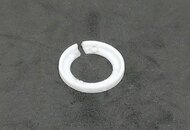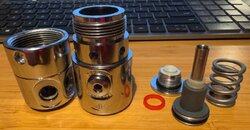kdlv
Contributor
Folks, 3 lame questions from my side
Some diagrams indicate the presence of a spring positioner.
Rev C from 12/1997 indicates only the presence of a washer/shim 01.060.101. #10 on the diagram
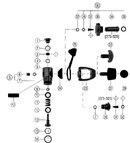
Rev M from 02/2001 of the diagrams however has now #34 - 10.500.118 which is a spring positioner washer. The piston, bushing and sleeve (#19,#33, #22) on the diagram look exactly like mine.
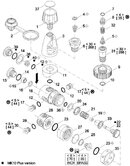
Same spring positioner/washer is on the previous Rev L as well from 03/99
Supposedly Rev M is the latest and I should have both at least 1 shim and the washer together contacting the main body and under the spring.
And then... there is the confusing MK10 Plus conversion infographic.
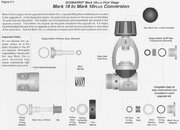
My piston looks similar to the Plus on the graphic, but the rings are not amber. It has the TIB, but doesn't show the silicone sleeve (#19 on diagrams)! I know mine is normal (non-Plus) MK10. But this diagram doesn't show the silicone sleeve at all, wondering why...?
* Now... my MK10 is in pristine condition and it has been serviced recently. It appears to be a late model. But... there is no spring positioner, just a shim under the spring and the tallest HP seat is installed. I couldn't test the IP at low tank pressure, to see if it drops significantly. Should I source one? And do I need a shim under it? Probably not...
* Is there a need to lubricate the piston stem under #33 cap?
* What is the right position of 19? the groove is on the outside, or the flat surface is on the outside? I assume the groove is on the outside like on the photo and it was like that when I took the piston out. #19 is soft and it is very easy to turn it inside out. What's the purpose of it?
{and then I found this topic: When did MK10 get spring alignment washer (10-500-118) and why?}
Some diagrams indicate the presence of a spring positioner.
Rev C from 12/1997 indicates only the presence of a washer/shim 01.060.101. #10 on the diagram

Rev M from 02/2001 of the diagrams however has now #34 - 10.500.118 which is a spring positioner washer. The piston, bushing and sleeve (#19,#33, #22) on the diagram look exactly like mine.

Same spring positioner/washer is on the previous Rev L as well from 03/99
Supposedly Rev M is the latest and I should have both at least 1 shim and the washer together contacting the main body and under the spring.
And then... there is the confusing MK10 Plus conversion infographic.

My piston looks similar to the Plus on the graphic, but the rings are not amber. It has the TIB, but doesn't show the silicone sleeve (#19 on diagrams)! I know mine is normal (non-Plus) MK10. But this diagram doesn't show the silicone sleeve at all, wondering why...?
* Now... my MK10 is in pristine condition and it has been serviced recently. It appears to be a late model. But... there is no spring positioner, just a shim under the spring and the tallest HP seat is installed. I couldn't test the IP at low tank pressure, to see if it drops significantly. Should I source one? And do I need a shim under it? Probably not...
* Is there a need to lubricate the piston stem under #33 cap?
* What is the right position of 19? the groove is on the outside, or the flat surface is on the outside? I assume the groove is on the outside like on the photo and it was like that when I took the piston out. #19 is soft and it is very easy to turn it inside out. What's the purpose of it?
{and then I found this topic: When did MK10 get spring alignment washer (10-500-118) and why?}



